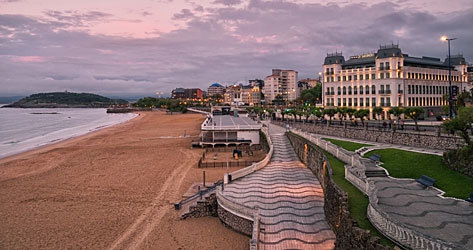- Almería: The new address to eat a good rice next to the beach
- V Centenario.Tordesillas: this is how the world was divided
There is in the bay of Santander , next to the Calderón Pier, a group of kids who usually spend their days counting waves. When the Santander sculptor José Cobo Calderón decided to sculpt them in bronze in 1999, the memory of those boys was already somewhat worn, just like the material in which they are forged. At his feet, a small plate saves those kids who are still straining today in many summer postcards harvested by selfie .
The appellation raquero comes from the verb raquear which, in turn, comes from the Latin rapid, -is and means taking the alien against the will of its owner. According to the RAE, "thief who steals in ports and coasts". In the past, the term was attributed to children who, in the late nineteenth and early twentieth centuries, wandered among the machinas of Puerto Chico, waiting for an unemployed crew member or a wealthy tourist to throw a coin into the water that they They could recover by diving.
By the time the Cantabrian historian José Ramón Saiz Viadero published, in the early 80's, his Dictionary for the use of rakers and, subsequently, Stories of rakers , both of Tantín Editions, that figure had already disappeared from the port scenarios, being reduced to a mere sentimental reference "I had lived with them in the postwar years, so I decided to move them back to the pages of a book, as authors as relevant as José María de Pereda had already done," he says.
The famous novelist referred to them in his Mountain Scenes with these words: "The purebred raker is born, precisely, in the High Street or in that of the Sea. His life is as scarce of interest as that of any other being, until he knows how to run like a squirrel: then he leaves the maternal home by the Naos Dock, and the given name by the graphic mote with which his companions confirm him; mote that, founded on some culminating fact of his life, he has to adopt with fists, if logical arguments resist. The same did their parents and the neighbors of their parents. In those neighborhoods all are pagan, judging by the saints of their names. "
LIVE MEMORY
Saiz Viadero remembers that this is not an exclusive character of Santander, but that it has existed in other places such as Cartagena (where it is called icue ), in La Caleta gaditana, in Lisbon and, in general, in all the populous places of the coast, "its presence represents not only the misery in which the existence of a sector of the child and youth population of those cities that had a large traffic in their ports, but also representative of the large number of children from the orphanages, with no other way out than loitering to seek life primarily as friends of others. "
Hence, the historian stresses the importance of keeping his memory alive because, otherwise, "Santander would lose a part of the sentimental signs of his identity, although they have already been bleached by some sectors of our society that, in moments of nostalgia , they acknowledge having been rakers in their infancy. People like builders often turn to that common identity place, "he says. "But we will always have literature, photography, painting and sculpture as means of reproduction of a past time that was not better but sometimes appears more alive in our memories."
According to the criteria of The Trust Project
Know more- Cantabria
- Travels
- tourism
EuropaPsirí, the hipster and eccentric neighborhood of Athens
ESCAPADA This is Nantes, the craziest and most creative city in France
The WalkerOhanes hosts the weekend A Night of Culture and Tradition, a festive center of the Alpujarra Almeria

